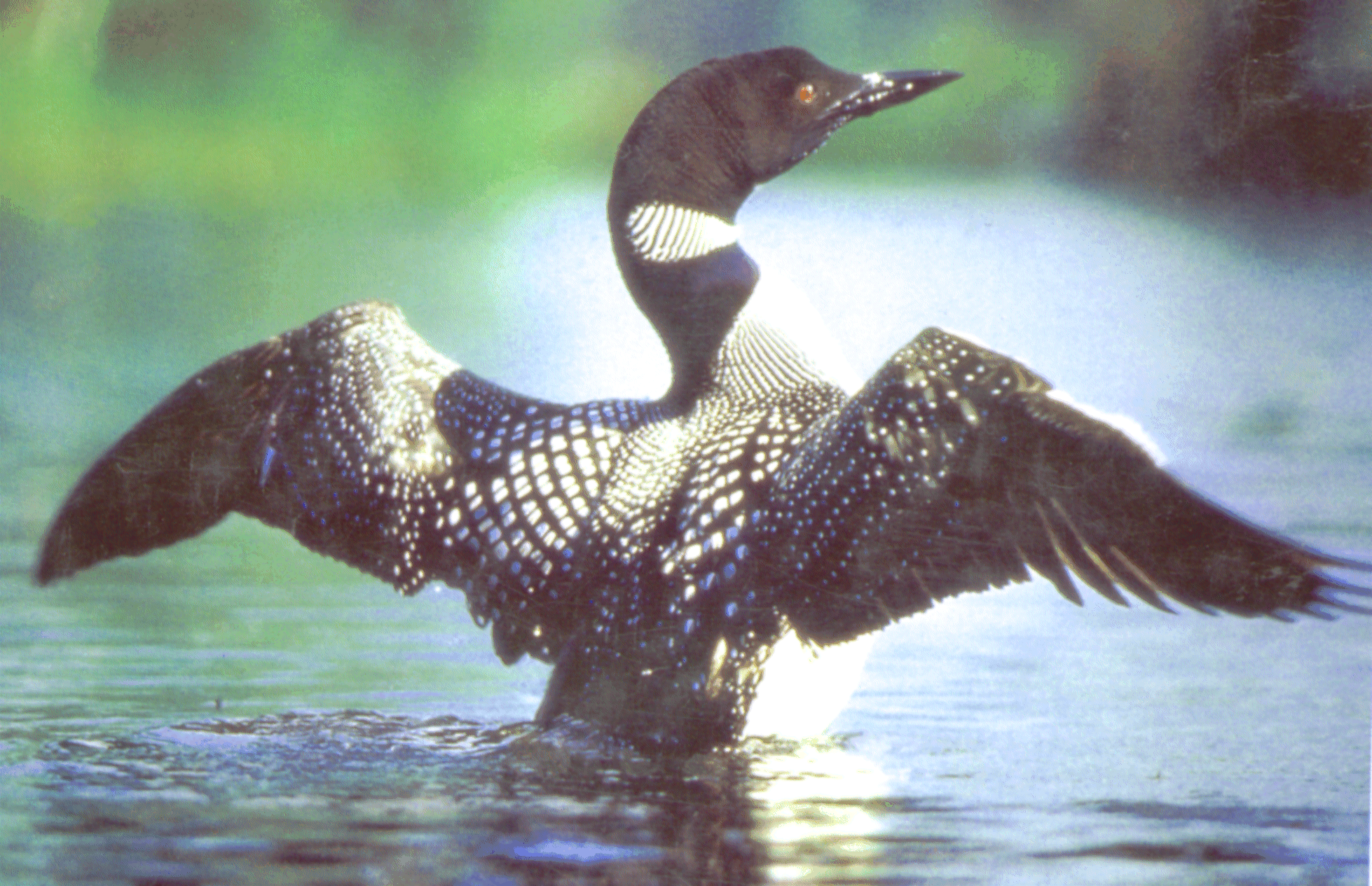
The common loon in full breeding plummage.
Problems Associated With Nesting Success
And Survival For the Common Loon
For
Dr. Matthew Pifer
Technical Writing Instructor
Lake Superior State University
Sault Sainte Marie, Michigan
By
Vivian S. Miller
English 205 Student
November 6, 2001

The Common Loon, Gavia Immer, is perhaps one of natures best indicators of an undisturbed habitat, virtually free from overpopulation, contaminates and other known human disturbances.
The average adult is 24-36" long, and may weigh between 6 ½ -11 pounds. The eyes are red. The bill is approximately 4" long, and is used to stab or grasp prey. While feeding the loon can dive up to 200 feet below surface and remain for 8-60 seconds, and when pursued by an enemy can remain up to 3 minutes. Amazingly the loon can fly up to 60 mph, with a wingspan of 58 inches, but cannot fly from land. Instead, it must have a long running start across the water surface to become airborne. The legs are located toward the rear of the body making them very clumsy on land, but the strong leg and webbed foot design make them excellent divers.
The coloration of breeding plumage is well known, and portrayed in the majority of photographs. Breeding plumage includes a black head, bill, and neck with a white and black-striped necklace. The back is checkered black and white, and the under parts are white. Unfortunately for these beautiful birds, successful nesting and population growth is directly related to human disturbance. In this report I will discuss courtship, nesting, and how human disturbance affects mortality and population decline of the common loon. The conclusion will cover a comprehensive recovery plan to restore these beautiful birds.
Courtship & Mating
Courtship and mating usually begins in April or May. Breeding range extends from Iceland, Greenland, and lake country areas of northern Canada and US. As a rule, loons don't breed for the first 3-4 years of life. During the breeding process, the loon will defend large territories from other loons, and they often return to the same range year after year. During courtship, loons usually approach one another slowly, dipping their bills rapidly in and out of the water. When meeting, they will put their heads together briefly and then dive, coming up almost instantly within a few feet from one another. This is usually followed by short, swift dives followed by exaggerated rolling preens and stretches. Although common loons are thought to mate for life, banding studies show that they will sometimes switch mates after failed nesting attempts, even between nesting in the same season. At the present time there are less then 400 breeding pairs in Michigan. After copulation, nesting begins.
Nesting & Incubation
Nesting usually takes place between mid May and late June. Preferred nesting sites include islands, sheltered coves, capes, headlands (close as possible to water), floating bogs, muskrat houses, or as a last resort a marshy shoreline. Lake islands and bog mats are optimal sites because they offer better protection from mammalian predators. Nests are constructed of matted grasses, rushes and twigs, and are sometimes built on bare soil or a depression.
Both parents incubate a clutch of 2, olive-green to dark brown eggs, usually scattered with dark brown spots. Incubation takes between 26 and 31 days, and the first chick is usually born 12-24 hours before the second. Because sibling rivalry is so intense, it is more common for one chick to survive than both. The young ride their parent's back to prevent hypothermia and predation from enemies. Unlike most aves, loon chicks are not fed by regurgitation, but by one day old are fed whole fishes, crustaceans, and bits of plants. By 10-13 days old they are skilled at swimming and diving, and by 8 weeks they can dive for their own food. Around 70-77 days old, the chicks attempt their first flight. It takes the full summer for the chicks to grow, and then the adults leave to join the others. The young soon follow.
Human Disturbance & Interference
Human disturbance and interference are the most important factors that affect the loon's nesting and survival success.
Human disturbance and interference takes many forms including shoreline development, watercraft disturbance, poisoning, and accidents.
Shoreline Development
Shoreline development, in the form of family homes, campgrounds and picnic areas are largely responsible for interfering with a loon's ability to successfully nest and reproduce. This increase in human population also causes an increase in garbage, which in turn attracts known loon predators such as raccoons and gulls. In addition, berry pickers, anglers, picnickers, campers, and part-time naturalists invade the shorelines causing the timid loon to vacate the nest.
Water Craft
Problems associated with careless watercraft operators involve intentional harassment, and causing more than a 6" wake. A few waves from a small watercraft can swamp the nest and cause the eggs to wash into the lake. Often the loon will attempt to re-nest, but with constant disturbances from watercraft is usually unsuccessful. Also, inconsiderate boaters have been known to chase loons around the lake until they die of exhaustion. At times the disturbance is an innocent act of being curious and getting too close to the nest, but still causes distress to the loon, sending them away from the nest.
Poisoning & Accidents
Another man-made problem resulting in unsuccessful increases in loon populations are associated with poisoning and accidents. Mercury and lead poisoning appear to be the main culprits affecting mortality due to ingestion. Because the loon is at the top of its food chain; they can ingest high amounts of mercury through their diet of fishes. In addition, lead poisoning is acquired in the same manner as the loon dines on fishes containing lead sinkers. Accidents involving human interference come by way of entanglement in fishing nets, causing the loon to drown. Other accidents are caused by entanglement in fishing line, that in turn causes injury that leads to infection. Finally, naturally occurring accidents happen when early winter ice sets in and the loon becomes icebound. Hypothermia is the cause of death in this instance.
Comprehensive Recovery Program
Interested citizens dedicated to preserving loons formed the Michigan Loon Preservation Association (MLPA) in the 1980's. It's primary goal was public education about the threatened status of the loon, and endorsing research that would enhance environmental conditions for successful populations. The Natural Heritage Program, in association with universities and MLPA is placing a major emphasis on loon population over the next few years. Their goal is to reassess the status and threats to loons in Michigan. Lake surveys were conducted in 1999 and will continue annually to provide a baseline of the population in the state. Researchers from Lake Superior State University will recommend changes to the loon reporting form that includes changes such as shoreline development and water quality.
Conclusion
In conclusion, the success of population expansion of the common loon is in the hands of each and every one of us. It is critical to remember that many problems associated with the decline of loon populations are directly man-made. Human disturbance, by way of increased shoreline development, increased watercraft on the lakes, poisoning, and accidents are important factors that affect successful nesting attempts for the common loon in Michigan. It is up to each individual to preserve and protect this natural resource for future generations.
References
Ashenday, J. (2000). Loons-Hinderland Who's Who-Canadian Wildlife Service-Environment[Online Web Site], Available WWW: http://www.cws-scf.ec.gc/hww-fap/loons/loons.html
Department of Natural Resources (2001). Common Loon Status [Online Web Site],Available WWW: http://www.dnr.state.mi.us/Wildlife.asp?sublinkid=150&Link=Sub&Li
Michigan Loon Preservation Association (2001). Common Loon in Michigan [Online Web Site] Available WWW: http://www.michiganloons.org/biology.htm
Robinson, W.L. (1999). A Brief History of Loons & Loon Management in Michigan [3 pages]Michigan Loon Preservation Association [Online Web Site], Available WWW:
http://www.michiganloons.org/History.htm
Terres, J.K. (1996). The Audubon Society Encyclopedia of North American Birds. Avenel: Wings Books.
|



